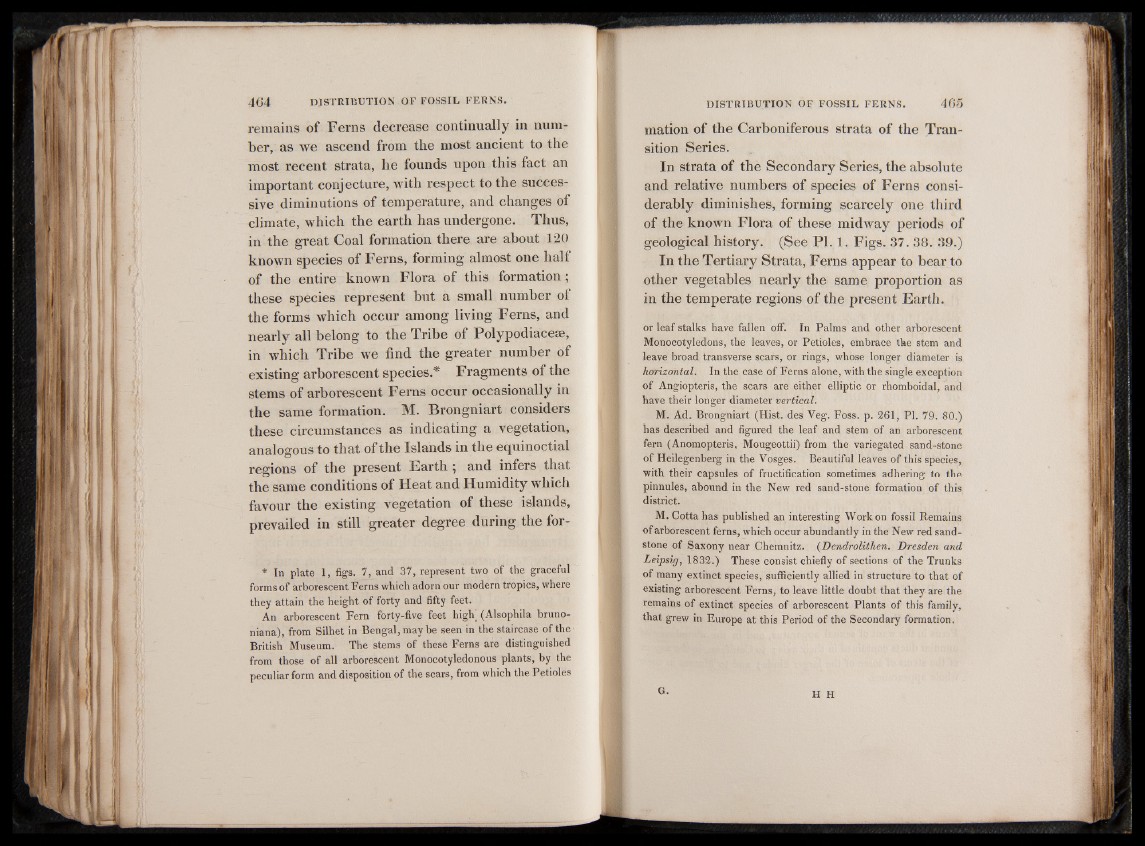
remains of Ferns decrease continually in number,
as we ascend from the most ancient to the
most recent strata, he founds upon this fact an
important conjecture, with respect to the successive
diminutions of temperature, and changes of
climate, which the earth has undergone. Thus,
in the great Coal formation there are about 120
known species of Ferns, forming almost one half
of the entire known Flora of this formation;
these species represent but a small number of
the forms which occur among living Ferns, and
nearly all belong to the Tribe of Polypodiaceae,
in which Tribe we find the greater number of
existing arborescent species.* Fragments of the
stems of arborescent Ferns occur occasionally in
the same formation. M. Brongniart considers
these circumstances as indicating a vegetation,
analogous to that of the Islands in the equinoctial
regions of the present Earth ; and infers that
the same conditions of Heat and Humidity which
favour the existing vegetation of these islands,
prevailed in still greater degree during the for-
* In plate 1, figs. 7, and 37, represent two of the graceful
forms of arborescent Ferns which adorn our modern tropics, where
they attain the height of forty and fifty feet.
An arborescent Fern forty-five feet highi (Alsophila bruno-
niana), from Silhet in Bengal, may be seen in the staircase of the
British Museum. The stems of these Ferns are distinguished
from those of all arborescent Monocotyledonous plants, by the
peculiar form and disposition of the scars, from which the Petioles
mation of the Carboniferous strata of the Transition
Series.
In strata of the Secondary Series, the absolute
and relative numbers of species of Ferns considerably
diminishes, forming scarcely one third
of the known Flora of these midway periods of
geological history. (See PI. 1. Figs. 37. 38. 39.)
In the Tertiary Strata, Ferns appear to bear to
other vegetables nearly the same proportion as
in the temperate regions of the present Earth.
or leaf stalks have fallen off. In Palms and other arborescent
Monocotyledons, the leaves, or Petioles, embrace the stem and
leave broad transverse scars, or rings, whose longer diameter is
horizontal. In the case of Ferns alone, with the single exception
of Angiopteris, the scars are either elliptic or rhomboidal, and
have their longer diameter vertical.
M. Ad. Brongniart (Hist, des Veg. Foss. p. 261, PI. 79. 80.)
has described and figured the leaf and stem of an arborescent
fern (Anomopteris, Mougeottii) from the variegated sand-stone
of Heilegenberg in the Vosges. Beautiful leaves of this species,
with their capsules of fructification sometimes adhering to the
pinnules, abound in the New red sand-stone formation of this
district.
M. Cotta has published an interesting Work on fossil Remains
of arborescent ferns, which occur abundantly in the New red sandstone
of Saxony near Chemnitz. (Dendrolithen. Dresden and
Leipsig, 1832.) These consist chiefly of sections of the Trunks
of many extinct species, sufficiently allied in structure to that of
existing arborescent Ferns, to leave little doubt that they are the
remains of extinct species of arborescent Plants of this family,
that grew in Europe at this Period of the Secondary formation.
G. H H